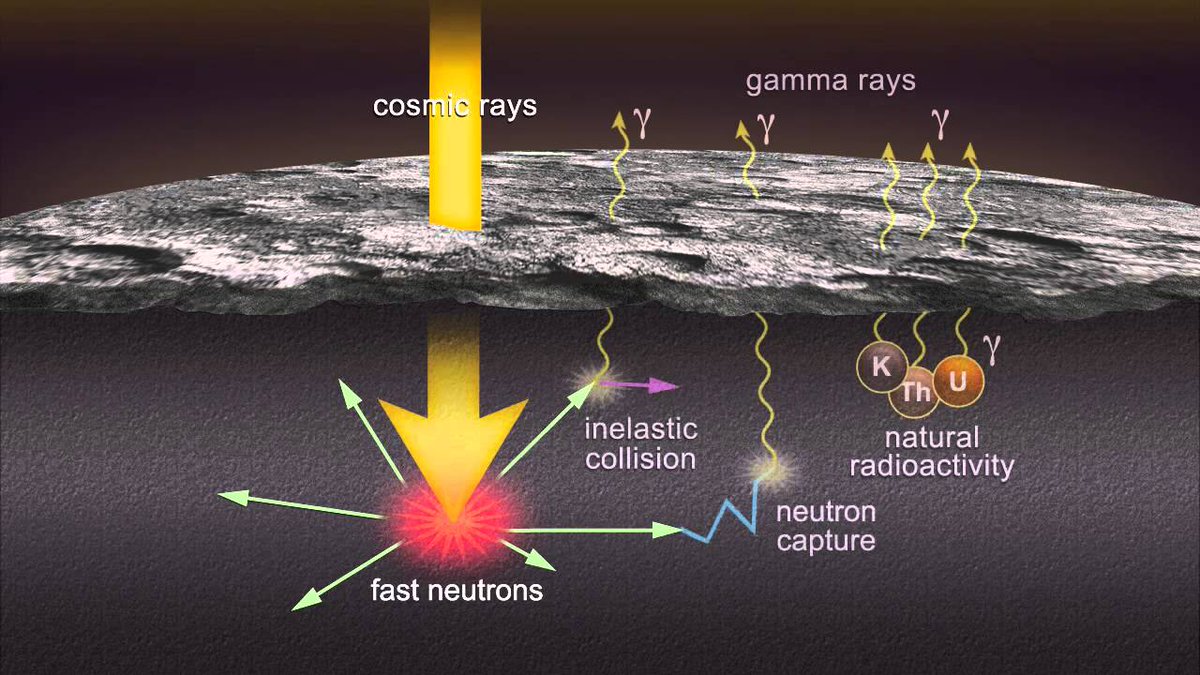
Cosmic rays are high-energy radiation, mainly originating outside the Solar System. Upon impact with the Earth's atmosphere, cosmic rays can produce showers of secondary particles that sometimes reach the surface. Composed primarily of high-energy protons and atomic nuclei, they are of mysterious origin. Data from the Fermi space telescope (2013) have been interpreted as evidence that a significant fraction of primary cosmic rays originate from the supernovae explosions of stars. Active galactic nuclei probably also produce cosmic rays. Wikipedia, Cosmic Ray
Are Cosmic Rays a part of what Keely called the "celestial" forces?
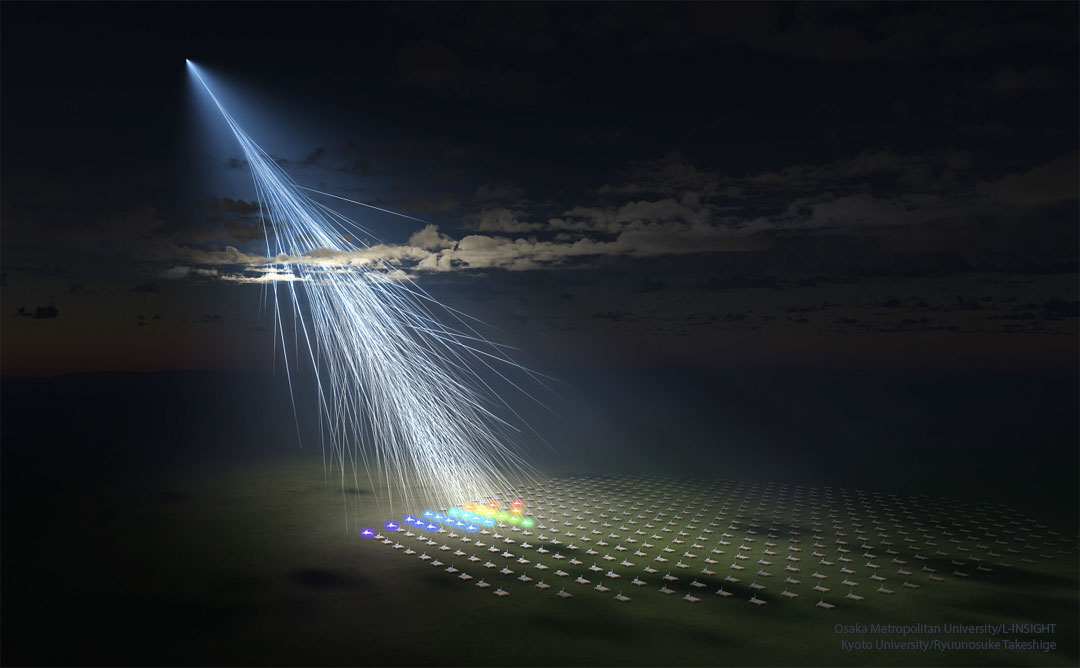
Energetic Particle Strikes the Earth Illustration Credit: Osaka Metropolitan U./L-INSIGHT, Kyoto U./Ryuunosuke Takeshige
Explanation: It was one of the most energetic particles ever known to strike the Earth -- but where did it come from? Dubbed Amaterasu after the Shinto sun goddess, this particle, as do all cosmic rays that strike the Earth's atmosphere, caused an air shower of electrons, protons, and other elementary particles to spray down onto the Earth below. In the featured illustration, a cosmic ray air shower is pictured striking the Telescope Array in Utah, USA, which recorded the Amaterasu event in 2021 May. Cosmic ray air showers are common enough that you likely have been in a particle spray yourself, although you likely wouldn't have noticed. The origin of this energetic particle, likely the nucleus of an atom, remains a mystery in two ways. First, it is not known how any single particle or atomic nucleus can practically acquire so much energy, and second, attempts to trace the particle back to where it originated did not indicate any likely potential source.
Ultra-high-energy cosmic ray:
In astroparticle physics, an ultra-high-energy cosmic ray (UHECR) is a cosmic ray particle with a kinetic energy greater than 10^18 eV, far beyond both the rest mass and energies typical of other cosmic ray particles.
The first observation of a cosmic ray particle with an energy exceeding 1.0×10^20 eV (16 J) was made at the Volcano Ranch experiment in New Mexico in 1962.
Cosmic rays are atomic nuclei that zip through space at the highest energies observed in nature. Some unknown engine accelerates them to energies 100 million times as high as that of protons in the Large Hadron Collider, the largest particle accelerator on Earth .
The largest study yet of the most energetic particles to slam into Earth provides the first solid clues to where the particles come from. Using a giant array of tubs of water, scientists found that these ultrahigh energy cosmic rays mostly originate outside the Milky Way.
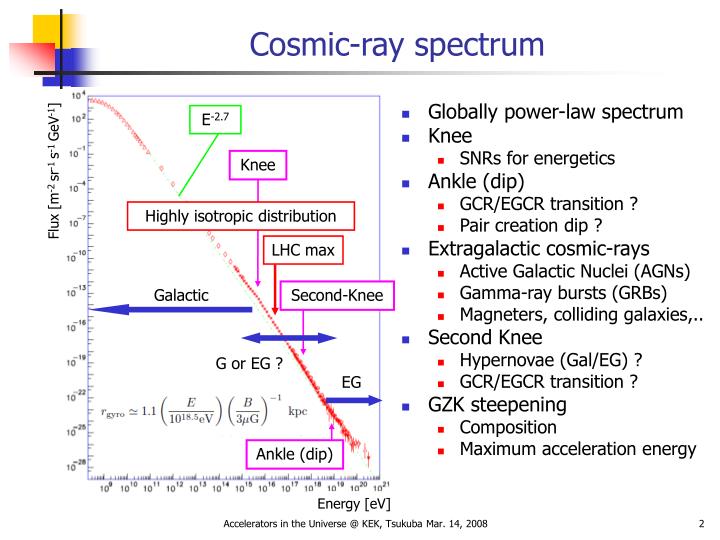
An international team analyzed about 12 years of data to show that particles with energies above 8 billion billion electron volts generally come from a particular direction in the sky, and it’s not the galaxy’s center.
Karl-Heinz Kampert of the University of Wuppertal in Germany, a spokesperson for the Pierre Auger Collaboration, which made the discovery said "It’s the first clear experimental indication that the sources of these high-energy particles are located outside of our own galaxy, probably somewhere in the nearby universe".
The observatory caught 30,000 ultrahigh energy cosmic rays between January 1, 2004, and August 31, 2016. The team found that, compared with the average density of particle strikes across the whole sky, about 6 percent fewer particles came from the center of the Milky Way. Slightly more particles came from a direction about 120 degrees away from the galactic center.
Karl-Heinz Kampert also said "Intriguingly, the excess points in the direction of the nearest cluster of galaxies to the Milky Way, located between 300 million and 900 million light-years from Earth. That finding suggests cosmic rays are produced in some galaxies, just not ours. Wikipedia, Ultra-high-energy cosmic ray
“Cosmic rays are mostly protons accelerated by some of the most energetic phenomena in the universe, like the blast waves of exploding stars and jets produced when matter falls into black holes,” explained Mazziotta.
These images show the steadily improving view of the Moon’s gamma-ray glow from NASA’s Fermi Gamma-ray Space Telescope. Each 5-by-5-degree image is centered on the Moon and shows gamma rays with energies above 31 million electron volts, or tens of millions of times that of visible light. At these energies, the Moon is actually brighter than the Sun. Brighter colors indicate greater numbers of gamma rays. This image sequence shows how longer exposure, ranging from two to 128 months (10.7 years), improved the view.
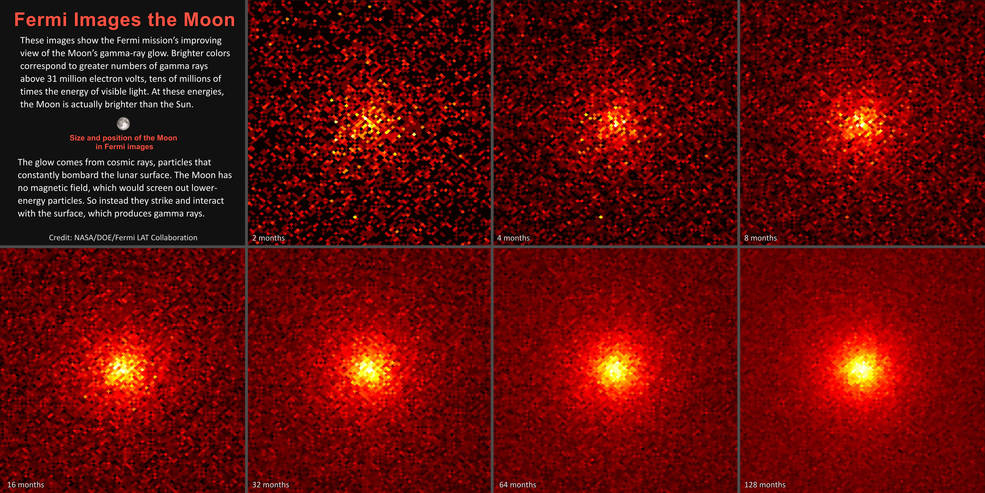
Source: http://www.ineffableisland.com/2019/08/moon-glows-brighter-than-sun-in-gamma.html
Cosmic rays
The earth is hit by elementary particles and atomic nuclei of very large energies. Most of them are protons (hydrogen nuclei) and all sorts of nuclei up to uranium (although anything heavier than nickel is very, very rare). Those are usually meant when talking about cosmic rays. Other energetic particles in the cosmos are mainly electrons and positrons, as well as gamma-rays and neutrinos.
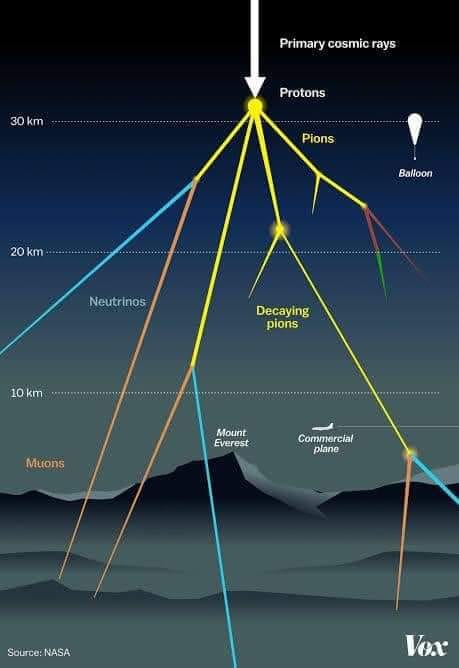
The number of particles starts to increase rapidly as this shower or cascade of particles moves downwards in the atmosphere. On their way and in each interaction the particles loose energy, however, and eventually will not be able to create new particles. After some point, the shower maximum, more particles are stopped than created and the number of shower particles declines. Only a small fraction of the particles usually comes down to the ground. How many actually come down depends on the energy and type of the incident cosmic ray and the ground altitude (sea or mountain level). Actual numbers are subject to large fluctuations.
These high-energy particles arriving from outer space are mainly (89%) protons – nuclei of hydrogen, the lightest and most common element in the universe – but they also include nuclei of helium (10%) and heavier nuclei (1%), all the way up to uranium. When they arrive at Earth, they collide with the nuclei of atoms in the upper atmosphere, creating more particles, mainly pions. The charged pions can swiftly decay, emitting particles called muons. Unlike pions, these do not interact strongly with matter, and can travel through the atmosphere to penetrate below ground. The rate of muons arriving at the surface of the Earth is such that about one per second passes through a volume the size of a person’s head.
The energies of the primary cosmic rays range from around 1 GeV – the energy of a relatively small particle accelerator – to as much as 108 TeV, far higher than the beam energy of the Large Hadron Collider. The rate at which these particles arrive at the top of the atmosphere falls off with increasing energy, from about 10 000 per square metre per second at 1 GeV to less than one per square kilometre per century for the highest energy particles. The very high-energy cosmic rays generate huge showers of up to 10 billion secondary particles or more, which can be picked up by particle detectors when they are spread over areas as large as 20 square kilometres on the surface of the Earth.
Just how do cosmic rays reach such high energies? Where are the natural accelerators? The lowest energy cosmic rays arrive from the Sun in a stream of charged particles known as the solar wind, but pinning down the origin of the higher-energy particles is made difficult as they twist and turn in the magnetic fields of interstellar space.
Clues have come through studying high-energy gamma rays from outer space. These are far fewer than the charged cosmic rays, but being electrically neutral they are not influenced by magnetic fields. They generate showers of secondary particles that can be detected on Earth and that point back towards the point of origin of the gamma rays. Sources of the highest energy gamma rays in our own galaxy, the Milky Way, include the remnants of supernovae, such as the famous Crab Nebula; the shock waves from these stellar explosions have long been proposed as possible natural accelerators. Other sources of ultra-high-energy gamma rays lie in other galaxies, where exotic objects such as supermassive black holes may drive the acceleration. There is also evidence that the highest energy charged cosmic rays also have similar origins in other galaxies.
Studies of cosmic rays opened the door to a world of particles beyond the confines of the atom: the first particle of antimatter, the positron (the antielectron) was discovered in 1932, the muon in 1937, followed by the pion, the kaon and several more. Until the advent of high-energy particle accelerators in the early 1950s, this natural radiation provided the only way to investigate the growing particle "zoo". Indeed, when CERN was founded in 1954, its convention included cosmic rays in the list of scientific interests. But even though accelerators came to provide the best hunting ground for new particles, the physics of cosmic rays is still widely studied.
Nikola Tesla
"I have satisfied myself that the cosmic rays are not generated by the formation of new matter in space, a process which would be like water running up a hill. Nor do they come to any appreciable amount from the stars.
According to my investigations the sun emits a radiation of such penetrative power that it is virtually impossible to absorb it in lead or other substances...
This ray, which I call the primary solar ray, gives rise to a secondary radiation by impact against the cosmic dust scattered through space. It is the secondary radiation which now is commonly called the cosmic ray, and comes, of course, equally from all directions in space.
...The phenomena of radioactivity are not the result of forces within the radioactive substances but are caused by this ray emitted by the sun. If radium could be screened effectively against this ray it would cease to be radioactive."
[Quoted in 'Tesla, 75, Predicts New Power Source', New York Times (5 Jul 1931), Section 2, 1.]
"Not to be fooled by their historical name, cosmic rays generally refer to high energy particles with mass whereas high energy in the form of gamma rays and/or X-rays are photons. These cosmic particles were discovered in 1912 by Victor Hess when he ascended to 5300 meters above sea level in a hot air balloon and detected significantly increased levels of ionization in the atmosphere.
"In many cases the cosmic rays are not directly observed and it is in fact the secondary effects such as gamma rays or neutrinos that are detected." https://www.resonancescience.org/blog/Particles-Are-Flying-Out-of-Earths-Poles
Russell
"The reverse of this principle applies in depolarizing bodies. Depolarizing bodies on the radioactive half of any cycle project time accumulations from them at tremendous speeds. Helium and other inert gases explode outwardly from tungsten at approximately half the "speed of light" while similar "rays" explode outwardly from radium, actinium, thorium, uranium and uridium at almost the speed of light.
Conversely, generoactive rays explode inwardly at tremendous speeds in the first three invisible octaves. Alpha, beta, gamma and "cosmic" rays explode inwardly to center invisible generating matter as they and the older inert gases explode outwardly from degenerating visible matter." [Walter Russell, A New Concept of the Universe, pages 112-117]
See Also
Celestial
Cloud Chamber
Cosmic Forces
gamma rays high energy level of light.
Interetheric
Intra-atomic energy
neutrino
15.08 - Dissociating Water with X-Rays - Radiolysis
